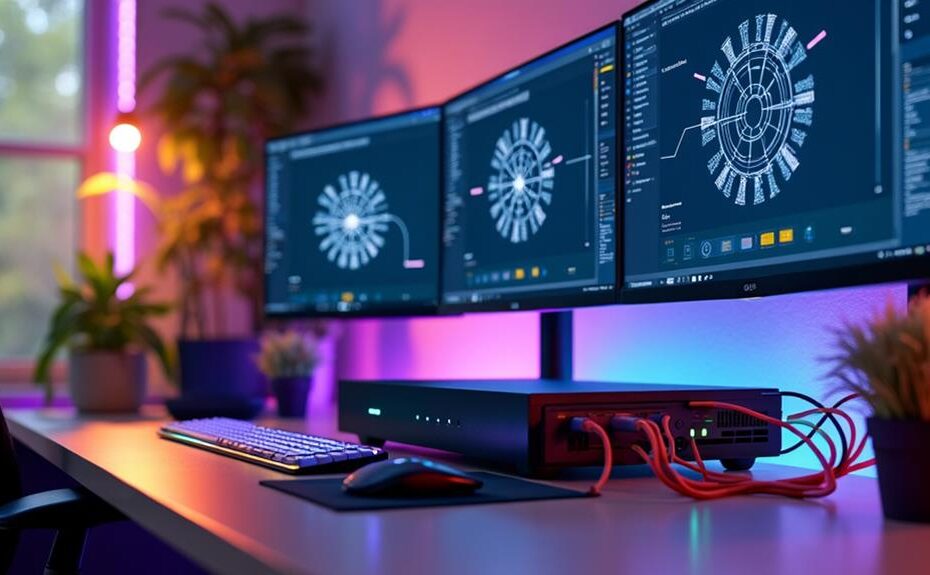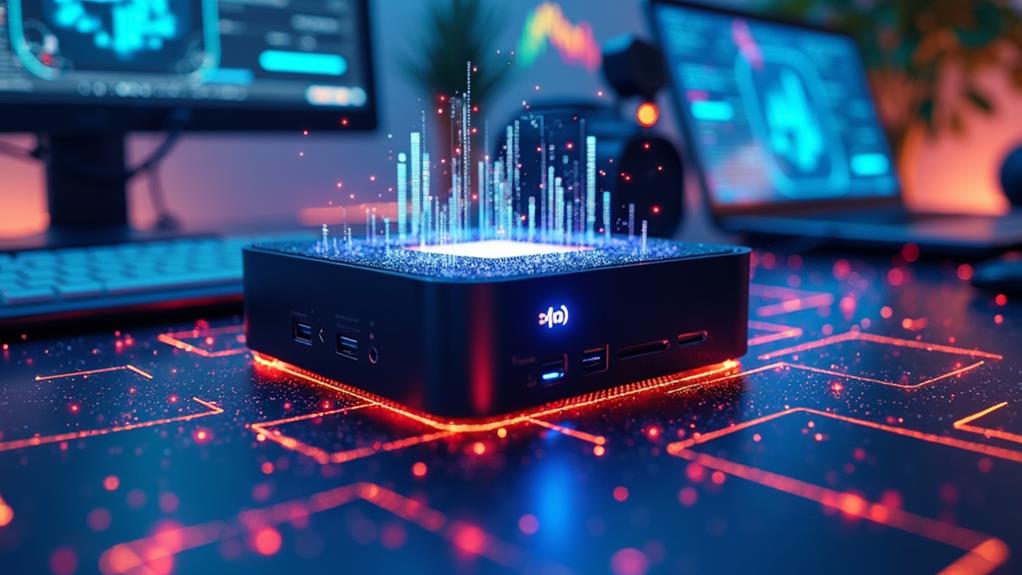



To set up an efficient mini PC network, start by selecting hardware with at least an Intel i5 or AMD Ryzen processor, 8GB of RAM, and a 256GB SSD. Configure the operating system, ensuring to assign static IP addresses for stability. Implement DHCP to manage IP assignments dynamically. Focus on network security by using strong passwords, a robust firewall, and regular system updates. Optimize performance by utilizing dual NICs for load balancing and monitoring network metrics. Address common issues by checking connections and updating drivers. There's much more to explore on enhancing your mini PC network's capabilities.
Key Takeaways
- Choose a Mini PC with at least an Intel i5 or AMD Ryzen processor, 8GB RAM, and 256GB SSD for optimal performance.
- Configure dual NICs for enhanced network reliability, load balancing, and improved data throughput.
- Implement strong security measures, including a firewall, VPN, and regular software updates to protect your network.
- Assign static IP addresses and utilize DHCP for efficient IP management across your network devices.
- Regularly monitor and optimize performance metrics to identify potential improvements and ensure network stability.
Understanding Mini PC Networks
When you consider the potential of Mini PCs in networking, you'll find they offer a compact yet powerful solution for various roles, such as servers, routers, or firewalls. These mini computers can enhance your network setup by providing efficient file sharing and media streaming capabilities. With their energy-efficient configurations, Mini PCs can also contribute to considerable cost savings and a lower environmental impact. One key advantage is their dual NIC configuration, allowing simultaneous connections to multiple networks, which greatly boosts network redundancy and overall performance.
Choosing the right operating system (OS) is essential for maximizing your Mini PC's functions. Options like Linux or Windows can be tailored for specific tasks, guaranteeing you get the most out of your device. As you configure your network connection, implementing appropriate security measures is critical—this includes setting up firewall rules to protect your data and regularly updating your configurations to maintain security.
Proper power management is also important; most Mini PCs run efficiently on 12V DC power supplies, and having battery backups can further secure reliability. By focusing on these elements, you can create a robust Mini PC network that meets your needs while maintaining peak performance and security.
Essential Hardware Requirements
To build a robust Mini PC network, you'll need to contemplate the hardware specifications that align with your intended tasks. Mini PCs offer a compact solution, but they must have sufficient processing power, such as an Intel i5 or AMD Ryzen, to handle your network tasks efficiently. For instance, the powerful AMD Ryzen 7 5700U processor featured in some Mini PCs provides excellent performance for demanding workloads.
Confirm your Mini PC includes adequate RAM, with a minimum of 8GB, to support multitasking, and opt for SSD storage of at least 256GB to provide fast data access and storage options. For enhanced networking capabilities, consider including dual NICs, which enable simultaneous connections to multiple networks, leading to improved reliability and performance.
Don't overlook the importance of connectivity options; your Mini PC should feature multiple USB ports, HDMI outputs, and Ethernet ports to facilitate seamless connections with peripherals and other devices. Finally, verify that the power supply matches the Mini PC's voltage requirements, typically 12V DC, to guarantee stable operation and energy efficiency during your initial setup. By prioritizing these essential hardware requirements, you'll lay a solid foundation for your Mini PC network, enabling peak performance and functionality.
Configuration and Setup Steps
Starting the configuration and setup of your Mini PC network requires careful attention to detail to guarantee peak performance. First, select a Mini PC with adequate processing power, memory, and storage tailored to your network's needs, making sure it features necessary connectivity options like Ethernet and HDMI ports. For ideal video conferencing, consider models like the GEEKOM Mini IT11 or the Intel NUC 10 Performance Kit, which are known for their robust capabilities.
Prepare the Mini PC for headless operation by connecting it to a compatible power supply and using an HDMI dongle if needed for initial setup. Next, configure the operating system and install necessary network drivers. Assign a static IP address to the Mini PC to make certain of consistent access within your local network.
Connect the Mini PC to your router via Ethernet, establishing a Wi-Fi network for additional device connectivity. Utilize DHCP to manage IP addresses effectively across your network.
Network Security Best Practices
Network security is essential for guaranteeing the integrity and safety of your Mini PC network. Start by implementing a robust firewall to monitor and control incoming and outgoing traffic, effectively shielding your devices from unauthorized access. Regularly update your operating system (OS) and server software to address the latest security patches, reducing vulnerabilities that cyber threats can exploit.
Utilize strong, unique passwords for all accounts linked to your Mini PC network. Consider adding two-factor authentication to enhance security and provide an extra layer of protection against unauthorized access. This combination will considerably lower the risk of breaches.
When accessing your network remotely, configure your Mini PC to use a Virtual Private Network (VPN). This guarantees encrypted connections, safeguarding your data from interception while transmitted over the internet.
Lastly, don't forget the importance of regular backups. Keep your data and configurations stored securely on an external solution, allowing for quick restoration in case of a security breach or system failure. By following these network security best practices, you'll be well-equipped to protect your Mini PC network from potential threats and guarantee continuous uptime.
Performance Optimization Techniques
After establishing a secure foundation for your Mini PC network, it's time to focus on enhancing its performance. Start by selecting a model equipped with either an AMD Ryzen or Intel Core processor that aligns with your application demands. This decision guarantees smooth performance during multitasking or network-intensive tasks. Upgrading your Mini PC's RAM to a minimum of 8GB and using an SSD for storage will greatly improve data access speeds and overall system responsiveness.
To further optimize performance, configure dual NICs to enable load balancing. This setup allows simultaneous connections to multiple networks, improving data throughput and reducing latency, especially during high-bandwidth activities like streaming and gaming. Regularly updating your operating system (OS) and networking drivers is essential, as it guarantees compatibility with the latest security features and performance enhancements, ultimately boosting stability.
Troubleshooting Common Issues
Troubleshooting common issues with your Mini PC network requires a systematic approach to pinpoint and resolve connectivity problems effectively. Start by verifying that all Ethernet cables are securely connected and inspect for any physical damage to ports or cables. Loose or damaged connections are frequent culprits behind connectivity issues.
Next, verify your network settings. Check the IP addresses and subnet masks to confirm they're correctly configured for your network environment. This step is vital for establishing a secure connection. If you suspect compatibility issues, updating your network drivers and firmware can notably enhance performance, as outdated software often leads to connection problems.
When issues persist, don't underestimate the power of a good restart. Restart your Mini PC and network devices, such as routers and switches, to refresh the network and clear any temporary glitches affecting connectivity.
Future Trends in Mini PC Networks
As mini PCs continue to evolve, their role in network environments is becoming increasingly significant, especially with advancements in connectivity and processing power. The integration of AI and machine learning in mini PCs is revolutionizing network management, allowing for intelligent load balancing and enhanced threat detection. This capability is vital as you incorporate more IoT devices into your setup, facilitating seamless connectivity and data processing for smart home and industrial applications.
The trend towards energy-efficient computing is also remarkable. Mini PCs are now designed with lower wattage components, which reduces operational costs while maintaining peak performance. Additionally, enhanced cybersecurity frameworks are being prioritized, featuring hardware-based encryption and advanced firewalls to protect sensitive data in your network infrastructure.
With the emergence of 5G technology, mini PC manufacturers are focusing on high-speed networking options. This trend enables faster data transfer and improved connectivity, essential for remote work and cloud applications. As you plan for the future, consider how these trends will shape your mini PC network, making it more efficient, secure, and integrated with the growing ecosystem of smart devices.
Disclosure: As an Amazon Associate, I earn from qualifying purchases.





